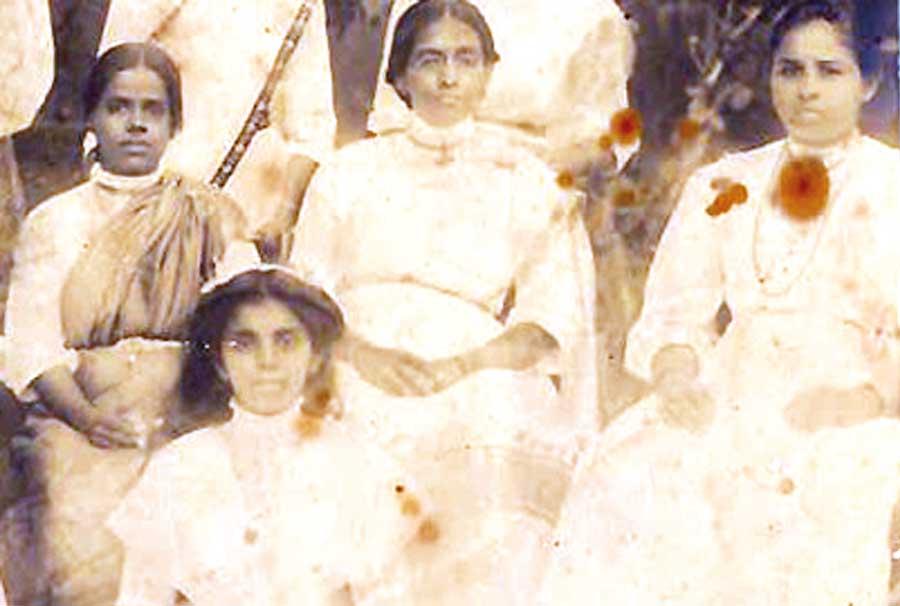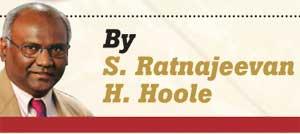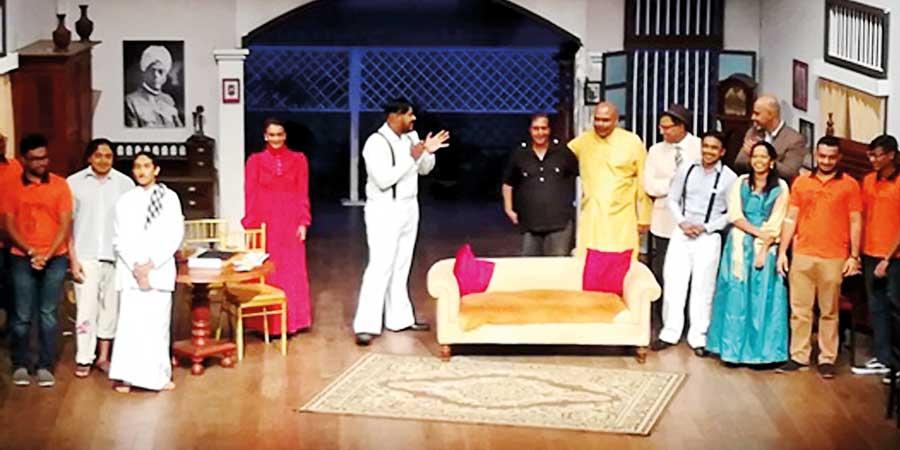22 Feb 2019 - {{hitsCtrl.values.hits}}
Being Trampled by a Cow after Falling Off the Palmyrah Tree

Sari Draped like Victorian Dress – St. James’ Nallur – Approx.1915
The Older version of He Comes from Jaffna
 It was in the 1960s that my parents took me to see the play at the then-new Veerasingham Hall in Jaffna. A key attraction was that producer Ernest MacIntyre and his sister Evelyn had been living within a hundred yards of our home down Chemmany Road with their aunt Mrs. “Engineer Chinnappah” nee MacIntyre, a former teacher at Chundikuli Girls’ College.
It was in the 1960s that my parents took me to see the play at the then-new Veerasingham Hall in Jaffna. A key attraction was that producer Ernest MacIntyre and his sister Evelyn had been living within a hundred yards of our home down Chemmany Road with their aunt Mrs. “Engineer Chinnappah” nee MacIntyre, a former teacher at Chundikuli Girls’ College.
I do not remember too much of the play from then except where Durai, the man from Jaffna, came to Colombo with drumsticks, and that scene where to evade a visitor the householder sends his wife to tell the visitor that he is busy in the toilet. And then the visitor insists on waiting. After a long fruitless wait, he remarks that he hears no noise from the toilet. The wife then tells him in a stilted Colombo sing-song accent “No, no. He is in the bathroom next to that bathroom.”
I remember going home happy, listening to contented comments exchanged by my parents. So, when the play was staged 15-17 February 2019 at the Lionel Wendt as the first version had been, I had to go with two of my daughters.
Unkindly Theme
The audience laughed a lot. They all seemed English-speaking. The play promotes the caricature of a miserly, untrusting North (epitomised by Durai) that attempts to influence a naive and generous South represented by Durai’s brother-in-law Raja, who is remarried to the European Marion. The play also propagates ideas of a backward, parsimonious, hierarchical Jaffna Tamil, while contrasting this with the generous, open-hearted, modern Colombo ‘Tamil’ who had renounced Jaffna. There is the added dynamic of Durai being Hindu and Raja a Christian.
Jaffna’s Durai blamed anyone who gave a loan without interest and said “must be from Jaffna” of any defaulter. The audience had many a laugh at the expense of the North. From what I have seen in Jaffna, loans are freely given to poor neighbours without surety, but even the poor had the dignity to bring as surety a wedding talisman or a goat saying “you will not worry about my defaulting and I will feel pressure to return the money as soon as I can.”
One of my daughters felt the play was saved by the last act. In it, they attempt to show Durai and Raja as two sides of the same coin. Both are shown as generous and family-oriented and learn from each other. In this sense, the play taught us how we can learn from our neighbours.
One of my daughters felt the play was saved by the last act. In it, they attempt to show Durai and Raja as two sides of the same coin. Both are shown as generous and family-oriented and learn from each other. In this sense, the play taught us how we can learn from our neighbours.
Looking Down
I am not surprised that it is a production from S. Thomas’ (and not St. Thomas’ as I have been “corrected” many times). I recalled from the crowd the time when I came first to Colombo and was laughed at for pronouncing captain as ‘captin’ and told it should be ‘captan’. My mother said not to mind it and told me that Chundikuli girls spoke good English until Colombo schools were evacuated during WWII in the expectation of a Japanese invasion, and Ladies’ College girls were sent to Chundikuli – just as “S Thomas’,” Gurutalawa was begun in 1942 to accommodate evacuee boys.
Balcony seats
Any wealth I have, I attribute to our saving for the next generation. Meaning we live carefully within our means, so our children can be secure. For example, we bought the cheapest balcony seats for the play and were happy to meet a Thomian Director from public service, but with clear Jaffna roots also there with us. Lionel Wendt was full save the balcony. Yet, the play seems to capture this cultural-nuance as an ungenerous spirit of the North.
Jaffna’s Calvinist and Puritan Thrift
The play draws on Jaffna’s legendary thriftiness to laugh at us. Why is this thrift especially true of Jaffna Tamils? It is because nearly all in Jaffna were Christian in Dutch times, with the Calvinist-Puritan emphasis on hard work and discipline. Jaffna, besides Galle and Colombo, is where church councils were formed with many Reformed Church Predikaants to spread the Gospel. As for the attitude to profit, it is said that when a Dutchman spoke of religious liberty, his king pulled out a Rix Dollar and said “Voila! Votre religion” – “There! Your religion”.
Since many Jaffna Tamils – nationalists who without any evidence claim to have resisted conversion – will contest that their ancestors were Christians, let me document it. Here is what Prof. S. Pathmanathan says (p. 17 in “Religion and Social Change in Northern Sri Lanka. 1796-1875: Protestant Missionary Activity and the Hindu Response” 1986):
“Under Dutch rule most of the inhabitants of Jaffnapatnam were officially reckoned as Christians. In 1722 Valentyn recorded that there were 189,388 Christians. It was found that there were 182,226 persons who could be considered as Christians in 1760.”
For, the Dutch required being a Christian to hold any Government office and to have a church wedding for the children to be eligible to inherit parental property. Thus by 1684, says Emerson Tennent (Christianity in Ceylon, London: John Murray, 1850, pp. 73-74), Jaffna had 180,364 Protestants in a population of 278,759, and by the year 1758 AD, says K.M. de Silva (A History of Sri Lanka, London: Hurst & Co.,1981, p. 196.) Jaffna had 200,233 Protestants. Allowing for the large numbers of Roman Catholics and Muslims who refused to convert, it would appear that practically most Hindus had converted to Christianity.
Caste: The Obverse
The other side of Jaffna is caste-consciousness which Puritanism could not stamp out. Caste claims for oneself means finding ways to feel superior to everybody else. Among other things, this means staking the current nationalist claims of denying that their ancestors were Christians. However, in moments of weakness when there is a need, I have seen many marriage proposals from staunch Hindus to Christian families claiming, and thereby admitting, that a generation earlier they were Christians.
Sometimes it is the need to boast. For example, the biographer of Ponnamabalam Ramanathan, M. Vythilingam (The Life of Ponnambalam Ramanathan, Colombo, 1971, Vol.1) lambastes Christians for converting to go after privileges and then, forgetting himself and what he wrote elsewhere in the same book, boasts that Ramanathan’s maternal grandmother’s father, Edirmannasinha Mudaliyar, held the office of Governor of the Vanni District under the Dutch. Vythilingam seemed not to be aware (William Howland, Historical Sketch of the Ceylon Mission, 1865, p. 7) that the Dutch made “assent to the Helvetic confession of faith necessary to the holding of any office of profit or trust under the government.” Edirmannasinha Mudaliyar was surely of the Dutch Reformed Church.
Positives of production
The costume and set design were remarkably done, as was the lighting and audio. The acting was good, especially Durai and Martin – with good pace, emotions, and improvisation (like when Durai’s son Danu accidentally broke a table but they improvised lines to incorporate that). Script was well-written.
Flaws
Set in 1908, the background of the set had a portrait of Ramanathan from a much later period.
The character Kamini Fernando did not reflect the sari of around 1908 which was draped to look like an English dress. Durai is rarely a name in Jaffna, which is far more likely to be Thurai. Durai in the play had a modern Sharvani of such shiny cloth as unavailable in 1908. In one newspaper depiction he is in an orange sannyasi costume and head dress.

The Cast with a Ramanathan Portrait from well after 1908
Drumsticks
When gifting drumsticks on his arrival from Jaffna, Durai gives a few and then takes back a few regretting his generosity to great applause. Most of the time I failed to understand why the audience was laughing or applauding.
A Jaffna director would know what it means to bring drumsticks and mangoes from our own compound and how much it is appreciated. In season, I always carried these to my aunts and cousins in Colombo. Today, with this kind of caricature, young men refuse to carry these. A kind of cultural genocide? I have regularly been carrying Jack fruits and pumpkin from our ancestral house to relations in Colombo.
A Triumphalist laugh at Jaffna
Unlike MacIntyre, a man steeped in Jaffna and its Calvinist and America-Ceylon Mission roots, this caricatured rendition lacked authenticity and identification with Jaffna. Indeed, of the cast of ten, there is only one Tamil, Danu Innasithamby. I venture that not one member of the cast understood and appreciated the strengths of Jaffna culture from that era.
Although this was an attempt to play on generalizations inoffensively, this satirical play highlighting a vulnerable population was harmfully divisive given the recent war and current ethnic-instability. I suddenly understood the Tamil saying about a bull trampling over a man who had fallen off a palmyra tree. Already many youths are shy to admit they are from Jaffna. This play will worsen the phenomenon.
Perhaps as an afterthought, in the last ten minutes of the two-hour play the characters discover what is good about Jaffna and decide to take the Yal Devi to Jaffna. Some consolation!
I come from Jaffna and am very proud of it.
30 Nov 2024 2 hours ago
30 Nov 2024 3 hours ago
29 Nov 2024 29 Nov 2024
29 Nov 2024 29 Nov 2024
29 Nov 2024 29 Nov 2024